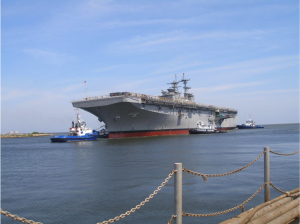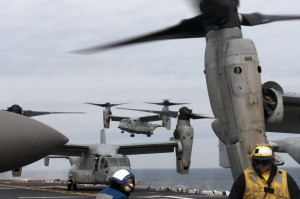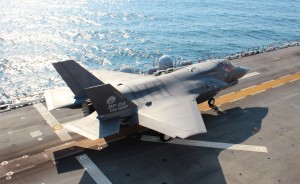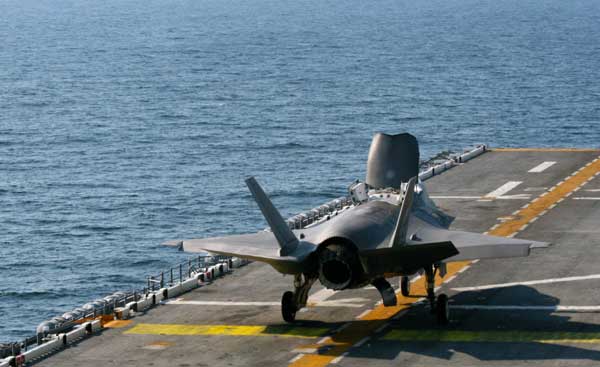2012-11-12 In a four-part follow up set of interviews, Second Line of Defense is looking at the role and impact of the USS America.
Interviews have been conducted with the prospective commander of the ship, the head of amphibious ship building in the USN, a senior USMC general on its role, and, finally, with the Deputy Commander, of the 2nd Expeditionary Strike Group, the role of the USS America as a flagship for an ESG is discussed.
- Each interview has allowed us to focus on different aspects of the process of change associated with the ship.
- With Captain Hall we were able to focus on the integration of different capabilities aboard the ship.
- With Captain Mercer, the head of amphibious ship building in the USN, we were able focus on the intersection between those capabilities and innovation in the fleet.
- With Major General Walsh, Deputy Commanding General of the USMC Combat Development Command, we focused on how the ship provides an important impulse to the USMC approach to the future.
- And with Col. Bradley Weisz, Deputy Commander of 2nd Expeditionary Strike Group, we focused on the role of the USS America as a potential flagship for an ESG.
We first met Col Weisz before and after BOLD ALLIGATOR 2012, an exercise that presages in many ways the role, which the USS AMERICA will play in future Expeditionary Strike Groups.
(For an earlier interview with Weisz on the USS America see the following:
https://sldinfo.com/the-coming-of-the-america-class-warship-to-the-usn-usmc-blue-green-team/).
In many ways, the operational characteristics of the USS AMERICA with its new aviation capabilities can lead to a re-naming of the ESG itself.

The point being is that the ship and its associated fleet elements are about presence, and the ability to provide extended forward presence. With MV-22 Ospreys and F-35 Bravos the ship can operate to envelop an adversary and to project force to where the enemy is not; rather than providing simple frontal assault, and pushing landing craft and amphibious assault vehicles ashore.
It is a different approach and a different capability; which has been presaged in BOLD ALLIGATOR 2012.
SLD: How does the AMERICA class LHA affect ESG operations?
Col Weisz: With its improved C5ISR capabilities as well as increased operational and planning spaces, the USS AMERICA can operate very effectively as an ESG Flagship. When the ESG Commander comes aboard the USS AMERICA, he or she will be able to command the Strike Group more effectively than in the past, than can be done with our current large deck amphibs.
Yes, the Command and Control (C2) capabilities will be quite similar to what we currently have aboard our large deck aircraft carriers, from a C5ISR point of view. You will also have access to critical operational and planning spaces that you currently see on both the USS BLUE RIDGE and USS MOUNT WHITNEY; very capable Fleet Command Ships.

SLD: With BOLD ALLIGATOR 2012, we saw a couple of lessons learned which might shape the way ahead for the AMERICA. The first was the launching of 16 Harriers off of the USS KEARSARGE and working with several large decks at the same time, and the challenges to managing command and control.
Col Weisz: For BOLD ALLIGATOR 12, we had 16 AV-8B Harriers operating aboard the USS KEARSARGE. All in all, it worked out fairly well. The Blue-Green Team, the Navy-Marine Corps Team, has done this before; specifically in Operations DESERT SHIELD, DESERT STORM, and more recently IRAQI FREEDOM; so the concept is well proven but will always need some adjustments according to the situation and environment you are operating in.
What we hadn’t done in awhile though was put two big deck amphibs, two LHDs, in close proximity of each other, so that caused us to work through some of our aviation command and control procedures and ensure we were always operating safely.
But again, the concept of using the big deck amphib as an AV-8B Harrier Carrier worked out well.
In the very near future, we will be able to do this same mission with 20 plus F-35 Bravos operating off the flight deck; which significantly increases our strike, EW, ISR and C2 capabilities.
Can you imagine what we could have done in support of Operation ODYSSEY DAWN if we had 20 plus F-35Bs on the USS AMERICA operating off the coast of Libya? Yes, one could have easily run the air war, the air campaign, from right there. The USS AMERICA with 20 plus F-35 Bravos aboard gives you a phenomenal strike, EW, ISR and C2 capability. It truly is a mini- aircraft carrier; very capable.
SLD: We have observed that one aspect that bringing a big warship like the USS AMERICA to the fleet is that provides for innovation in the entire strike capabilities of the fleet.
Col Weisz: Yes, currently Rear Admiral Terry Kraft from the Navy Warfare Development Command here in Norfolk, is running the AMERICA class LHA integration initiative. He is a former Carrier Strike Group Commander; in fact, he recently commanded the ENTERPRISE Carrier Strike Group in support of Operations ENDURING FREEDOM and IRAQI FREEDOM.
He is utilizing his extensive experience as a Naval Flight Officer with thousands of flight hours operating from large deck aircraft carriers and applying them to both the AMERICA class LHA and FORD class CVN integration initiatives.
His Chief of Staff is Captain Pete Pagano, former Phibron Four Commodore who led the KEARSARGE ARG strike operations in support of Operation ODYSSEY DAWN in Libya.
SLD: We have observed as well that there is a new role for the “black shoes” in all of this. The surface navy can play an ever-greater role than in the immediate past as the AMERICA enters the fleet. When you have an officer like Captain Hall, prospective commander of the USS AMERICA, who really is very, very knowledgeable about the weapons aboard the Aegis and the systems aboard the Aegis, he can actually start thinking as he gets his 35s airborne about the relationship between this ship and Aegis and the other surface combatants.
There’s a real revolution possible here and shaping approaches to get better value out of the capabilities we’ve already put on the destroyer class.
Col Weisz: Yes, that is a great point. The current commander for Expeditionary Strike Group TWO is Rear Admiral Ann Phillips, a Surface Warfare Officer. She was the first Commanding Officer of the USS MUSTIN (DDG 89), the Commodore of Destroyer Squadron 28 and the recent Director of Surface Warfare (OPNAV N86).
She is a subject matter expert in the surface warfare community and has the right background to understand how the surface combatant fleet like cruisers and destroyers can effectively integrate with the amphibious warfare ships; it is those kind of officers that are able to integrate and network these systems together.
SLD: Another aspect of an AMERICA led task force or ESG is its “chameleon” like quality. It can hold a variety of assets, which can be mixed or matched for the mission. It can be a full up F-35B strike ship with 19-23 planes; or have a majority of Ospreys or more CH-53s aboard to carry equipment ashore.
It is a flexibility that can signal to the enemy presence; but not present a final statement as to capability.

Col Weisz: An AMERICA class ESG can perform a variety of amphibious missions, depending on the capabilities aboard. You can deploy the ESG to lead a humanitarian assistance and disaster relief mission, what we can HA/DR.
You can have the AMERICA class ESG lead a large scale non-combatant evacuation operation, a NEO, where thousands of US, Coalition and Third Country Nationals need help. You can beef up the America class ESG so that it can conduct major combat operations; utilizing its robust strike capabilities.
You can even add Special Operations to the ESG, giving yourself a unique niche capability.
SLD: Let us close on discussing how the new ship and its capabilities might lead to a different approach to integrating a surface and subsurface ship task force. Rather than using the Carrier Battle Group concept as the organizing principle, there now is the possibility of getting very creative in terms of ESG approaches and concepts. What are the possibilities?
Col Weisz: The possibilities are numerous and there is significant potential, great potential, for innovation here. You have to remember that cruisers, destroyers and submarines use to deploy with the ESG. Then we moved away from that concept.
With F-35Bs, MV-22Bs and soon to be CH-53Ks aboard AMERICA class LHAs, I think there could be a return to these deployments, with a significant focus on strike, raid and ISR capabilities.
This is a great time for innovation across the fleet.
For the first two interviews in this series see the following:
https://sldinfo.com/captain-hall-discusses-the-uss-america-looking-towards-the-future/
https://sldinfo.com/ship-design-and-innovation-captain-mercer-discusses-the-uss-america/


